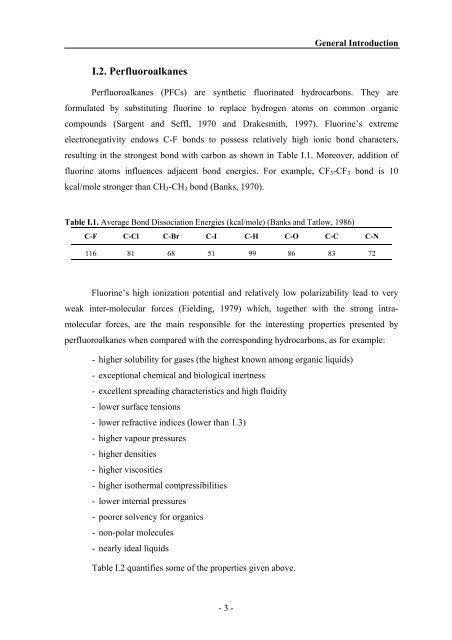n - PATh :.: Process and Product Applied Thermodynamics research ...
n - PATh :.: Process and Product Applied Thermodynamics research ...
n - PATh :.: Process and Product Applied Thermodynamics research ...
Create successful ePaper yourself
Turn your PDF publications into a flip-book with our unique Google optimized e-Paper software.
I.2. Perfluoroalkanes<br />
General Introduction<br />
Perfluoroalkanes (PFCs) are synthetic fluorinated hydrocarbons. They are<br />
formulated by substituting fluorine to replace hydrogen atoms on common organic<br />
compounds (Sargent <strong>and</strong> Seffl, 1970 <strong>and</strong> Drakesmith, 1997). Fluorine’s extreme<br />
electronegativity endows C-F bonds to possess relatively high ionic bond characters,<br />
resulting in the strongest bond with carbon as shown in Table I.1. Moreover, addition of<br />
fluorine atoms influences adjacent bond energies. For example, CF3-CF3 bond is 10<br />
kcal/mole stronger than CH3-CH3 bond (Banks, 1970).<br />
Table I.1. Average Bond Dissociation Energies (kcal/mole) (Banks <strong>and</strong> Tatlow, 1986)<br />
C-F C-Cl C-Br C-I C-H C-O C-C C-N<br />
116 81 68 51 99 86 83 72<br />
Fluorine’s high ionization potential <strong>and</strong> relatively low polarizability lead to very<br />
weak inter-molecular forces (Fielding, 1979) which, together with the strong intramolecular<br />
forces, are the main responsible for the interesting properties presented by<br />
perfluoroalkanes when compared with the corresponding hydrocarbons, as for example:<br />
- higher solubility for gases (the highest known among organic liquids)<br />
- exceptional chemical <strong>and</strong> biological inertness<br />
- excellent spreading characteristics <strong>and</strong> high fluidity<br />
- lower surface tensions<br />
- lower refractive indices (lower than 1.3)<br />
- higher vapour pressures<br />
- higher densities<br />
- higher viscosities<br />
- higher isothermal compressibilities<br />
- lower internal pressures<br />
- poorer solvency for organics<br />
- non-polar molecules<br />
- nearly ideal liquids<br />
Table I.2 quantifies some of the properties given above.<br />
- 3 -



